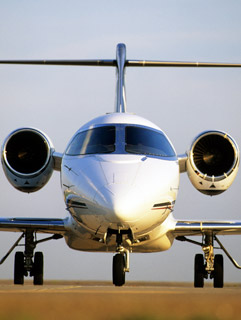Quick Look: Bombardier Learjet 45
A Lear goes large-cabin
 When it was introduced in the early 1990s, the Learjet 45 was the first clean-sheet Learjet design since the first-generation Model 23 helped bring business aviation into the jet age in the early 1960s.
When it was introduced in the early 1990s, the Learjet 45 was the first clean-sheet Learjet design since the first-generation Model 23 helped bring business aviation into the jet age in the early 1960s.
Bombardier’s goal in creating the eight-passenger, winglet-equipped Learjet 45 was to offer the performance and economy of a light jet with the passenger amenities of a mid-size jet. The fuselage has a noncircular cross section that offers more head and shoulder room than older Lears. A typical cabin configuration is double club seating (with an optional belted potty seat), with a galley and/or a lavatory. An external baggage compartment provides 50 cubic feet of storage space.
The Learjet 45 was powered by Honeywell TFE731-20 turbofans, flat-rated at 3,500 pounds of thrust, with digital electronic engine controls and Dee Howard thrust reversers. A Honeywell RE 100 auxiliary power unit provides ground power. The cockpit is equipped with Honeywell Primus 1000 avionics. The integrated system features four eight-inch by seven-inch displays. The instrument panel also includes Honeywell Primus II radios, a Primus 650 weather radar, a Universal UNS-1C flight management system, and an optional TCAS II.
The Learjet 45 made its first flight on October 7, 1995; FAA certification occurred in September 1997; and initial deliveries were made in mid-1998. In May 2002, less than four years after the Learjet 45 entered service, the 200th airplane was delivered. In July 2002 Bombardier introduced the higher-gross-weight Learjet 45XR. The improved model received FAA certification in June 2004.
Thanks to an engine upgrade to the TFE731-20BR, the 45XR features higher cruise speeds, faster climb rates, and better hot-and-high runway performance compared to the original Learjet 45. The new model also includes an improved Universal UNS1-E flight management system and a redesigned interior with more legroom, seat width, and galley storage. Bombardier provided Model 45 operators the opportunity to upgrade their aircraft via service bulletins.
Flexjet, the fractional aircraft provider, operates a fleet of Learjet 45s, and Singapore Airlines and Cathay Pacific Airways have used the jets for training. Peru and Ireland fly military versions of the aircraft.
In recent years Bombardier and independent service providers have introduced several enhancements for the Learjet 45/45XR, including a wide area augmentation system capable flight management system and WiFi installations. In May 2012 Bombardier announced the Learjet 45XR’s successor, the Learjet 75. The first production model of the new airplane debuted in May 2013.
According to Vref, more than 450 Learjet 45/45s have been built. An early model (1998) Learjet 45 can cost $2.6 million, while the asking price for a late-model (2012) Model 45XR is up to $9 million.
Robert A. Searles is an aviation writer and editor.
SPEC SHEET
Learjet 45/45XR
Engines | Two Honeywell TFE731-20AR or -20BR
turbofans, 3,500 lbs thrust each
Seats | up to 11
Max takeoff weight | 21,500 lbs
Cruise speed | 454 kts
Takeoff field length | 4,200 ft
Landing field length | 2,990 ft
Range (with IFR reserves) | 2,186 nm
Wingspan | 47 ft 9 in
Length | 57 ft 7 in
Height | 14 ft 2 in


